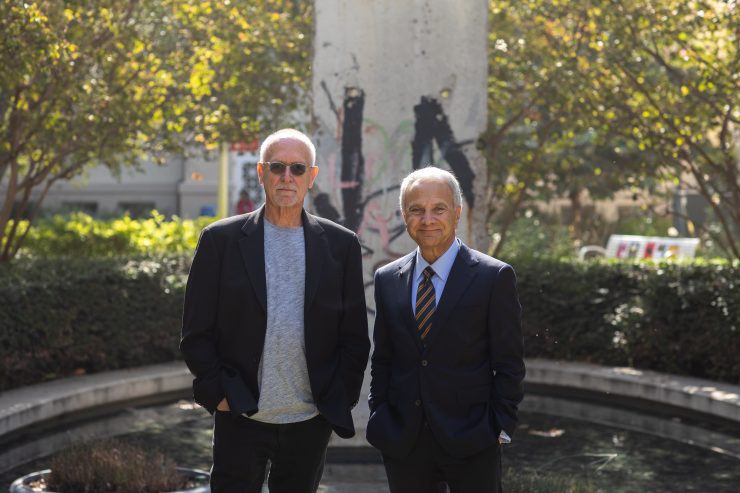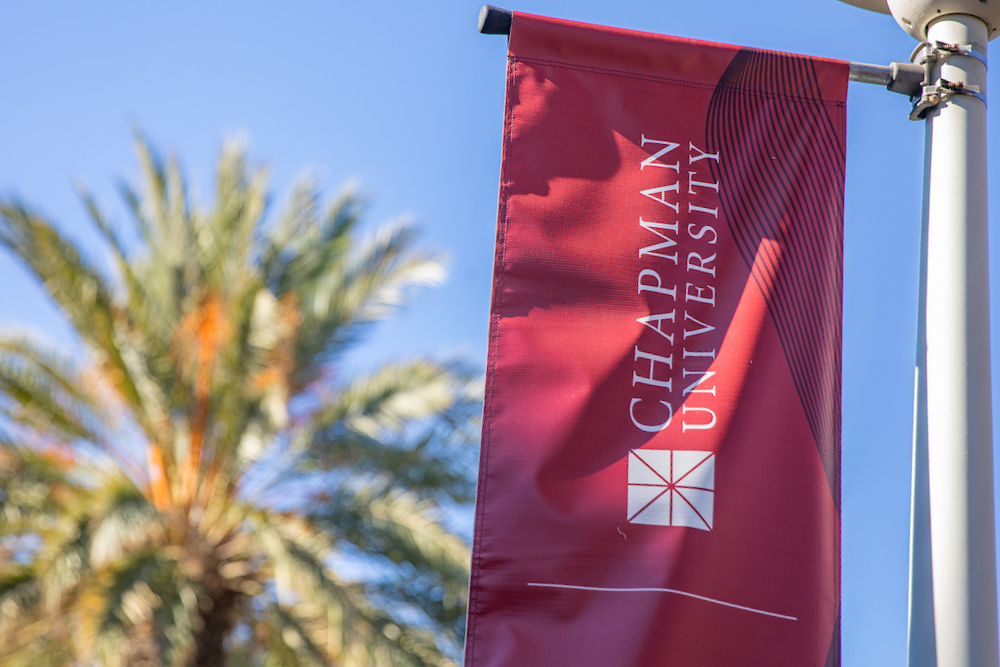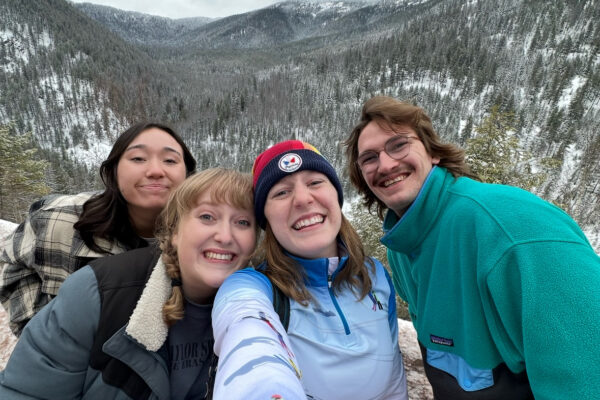On a sunny November afternoon, artist Richard Turner gazes out across the shaded pond that encircles a fragment of the Berlin Wall in Chapman University’s Liberty Plaza. For Turner, who designed the plaza 22 years ago, the power and strength of the monument remains unchanged.
The Bible quote paraphrased by Abraham Lincoln, 16th president of the United States, “A house divided cannot stand,” served as key inspiration for the monument’s design and is chiseled in the stone that surrounds the pond. When the professor emeritus chose those words for Liberty Plaza years ago, the Cold War, the long shadows of Vietnam and a racially-charged United States were on his mind.
Times may have changed, but the words resonate more than ever, he says.
“Today, our country is even more polarized and you can see that that Lincoln’s quotation is more relevant today than it was when I designed this memorial,” Turner reflects.
It’s been 30 years since the fall of the Berlin Wall that marked the end of the Cold War on Nov. 9, 1989. The Wall wasn’t just a physical barrier that divided East and West Berlin—it was a symbol of freedom-crushing Communist Soviet power.
For most Chapman students, this historically significant event occurred more than a decade before they were born. The project began in 1997 when President Emeritus Jim Doti secured one of the last pieces of the Berlin Wall. Now, Liberty Plaza is home to Chapman’s own fragment of the Berlin Wall, situated in a quiet area near Roosevelt Hall and surrounded by thick hedge, set apart from the hustle and bustle of students as they rush to class.
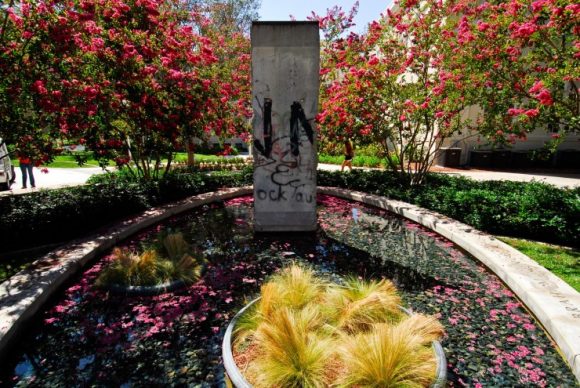
Bringing the Wall to Chapman
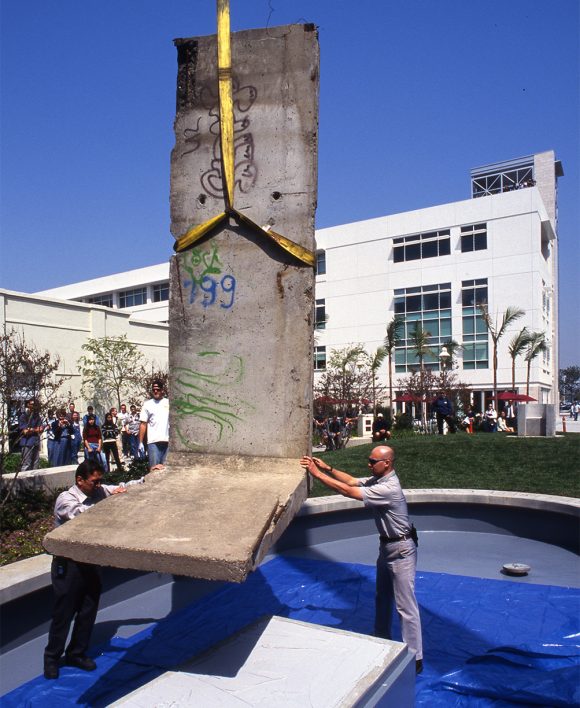
A visit to the Berlin Wall monument at the Ronald Reagan Presidential Library in 1996 inspired Doti to bring a piece of the Wall to Chapman. “I said ‘this is something we’ve got to get at Chapman,’ it’s such an important part of history,” Doti says.
Doti contacted the mayor of Berlin to secure a piece of the Wall with the help of Marilyn Harran, Ph.D. and director of the Rodgers Center for Holocaust Education, who translated his letters into German. The city of Berlin had decided to keep the remaining pieces of the Wall but they had one piece left to give away. Former U.S. representative Chris Cox helped clear bureaucratic red tape that allowed Chapman to claim the piece.
But the task of transporting the giant concrete slab was far from simple. Ever resourceful, Doti found Global Transportation Service Inc. in the Yellow Pages and called them up. After hearing Doti’s dream to bring the Berlin Wall fragment to Chapman, the company’s chairman, Guy Fox, offered to transport the fragment for free.
On Sept. 8, 1997, the Berlin Wall fragment arrived after a four-week journey by crane, ship, truck and train.
The Design
For President Doti, having a piece of the Wall wasn’t enough; the wall fragment needed a fitting home. The task went to public artist Richard Turner, who envisioned a grander space that would “expand the presence of peace into the landscape.”
With funding by Lord Swraj Paul, a member of the House of Lords in the British Parliament, Norma and Bob Lineberger, and Libby and Ed Pankey, Liberty Plaza became a reality.
Inspired by the Lincoln Memorial, Turner included a large chair in his design that sits facing the wall fragment.
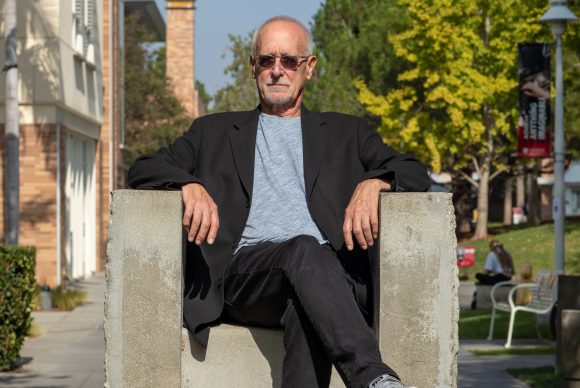
“I was trying to balance this huge chunk of concrete with a human being,” says Turner. “It seemed to me to be a way of an appropriate way of contemplating the legacy and the meaning of the fall of the wall.”
The idea of “a house divided cannot stand,” seemed to Turner to tell the story of the times.
“That seemed to be the key to the whole idea of this piece. Not only was that the story of East and West Germany, but that was such a metaphor for the struggles of our own country,” says Turner.
Originally, the plan placed the Lincoln-inspired chair facing the wall on flat ground, but Turner thought it made the wall seem too intimidating and grand. Working with landscapers, Turner came up with a plan to place the chair on a grassy mound facing the wall.
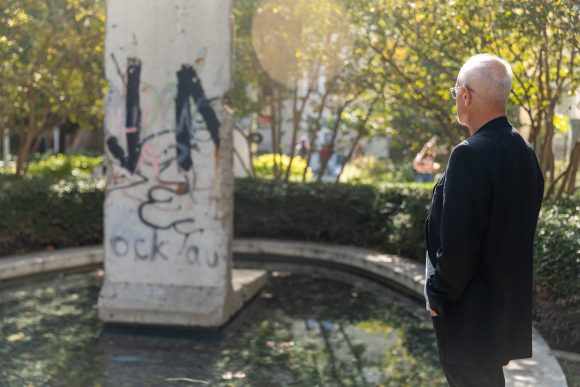
“The mound brings the seat up high enough so that you can look straight across at the Berlin Wall and there’s a kind of an equity between democracy and totalitarianism. It’s not like the totalitarian wins just because it’s so big and so tall and brutal,” says Turner. “You think, ‘I’m up this high and I can look straight at your cracks and look you in the eye, in a sense.”
The Legacy
Today, Liberty Plaza remains a top landmark on Chapman’s campus. A special anti-graffiti coating preserves the original graffiti while keeping the wall fragment untouched for future generations.
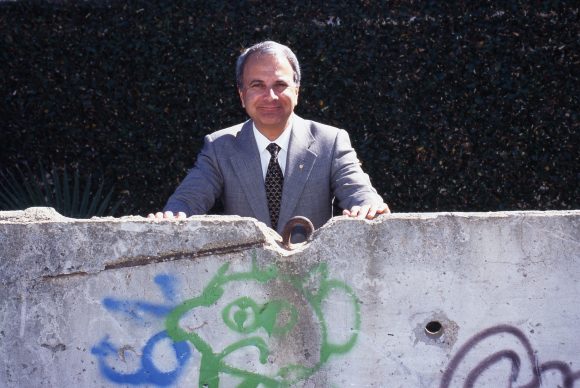
“How could you not be touched or emotionally moved when you when you see that,” says Doti. “What has made our presentation of the Berlin wall so special is what Richard Turner made possible by putting it into that artistic context that gave it meaning not only as a symbol of totalitarianism, but connecting it with this idea of freedom. It’s not just a piece of art—it’s become something that evokes historical memory.”
It’s not just a piece of art—it’s become something that evokes historical memory.
Set prominently in a highly-trafficked area on campus, Liberty Plaza is hard to miss.
“It’s not just a chunk of history that’s set off in some corner,” says Turner. “This is one of those key spaces on campus. It says to visitors and to students that this is not just some bauble that we’re collecting; this is something that physically is central to our mission, this is something that we think is important … It’s a reflection of aspects of Chapman’s mission.”
Liberty Plaza reminds Chapman’s students that the fight to stay free is central to the American spirit, and to the human spirit.
“It’s even more appropriate now to think about it. Even though the Berlin Wall is no longer separating East and West Berlin, there will always be this conflict between freedom and the lack of freedom,” says Doti. “Presented in this way, I think this helps get our students thinking about it.”
The Border Conference will begin on Thursday, Nov. 14, with a short remembrance of the fall of the Berlin Wall at 6:15 p.m. at Liberty Plaza.
Special thanks to the Leatherby Libraries Special Collections and Archives for research assistance.
